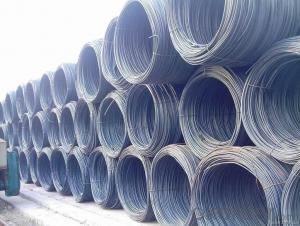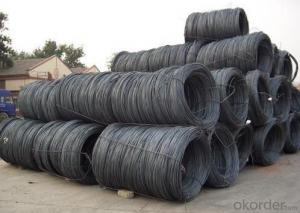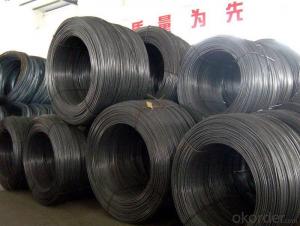Wire Rods Steel for Construction/ Concrete Usage
- Loading Port:
- Tianjin
- Payment Terms:
- TT or LC
- Min Order Qty:
- 28 m.t.
- Supply Capability:
- 40000 m.t./month
OKorder Service Pledge
OKorder Financial Service
You Might Also Like
Product Description:
OKorder is offering Wire Rods Steel for Construction/ Concrete Usage at great prices with worldwide shipping. Our supplier is a world-class manufacturer of steel, with our products utilized the world over. OKorder annually supplies products to European, North American and Asian markets. We provide quotations within 24 hours of receiving an inquiry and guarantee competitive prices.
Product Applications:
Wire Rods Steel for Construction/ Concrete Usage are ideal for structural applications and are widely used in the construction of buildings and bridges, and the manufacturing, petrochemical, and transportation industries.
Product Advantages:
OKorder's Wire Rods Steel for Construction/ Concrete Usage are durable, strong, and resist corrosion.
Main Product Features:
· Premium quality
· Prompt delivery & seaworthy packing (30 days after receiving deposit)
· Corrosion resistance
· Can be recycled and reused
· Mill test certification
· Professional Service
· Competitive pricing
Product Specifications:
wire rod:
Grade:SAE1006B/SAE1008B/SAE1018B
Size:5.5/6.5/7/8/9/10/11/12mm
wire rods are suitable for a wide range of applications such as : -
fasteners, bolts, rivets, screws,
general purpose wires,
electrode wires, industrial wires, agriculture wires,
bush wires, chain rivet wires,
detonator wire,
Umbrella ribs, upholstery wires, cycle spokes, needle wires, heald wires, staple pin Wire, safety pin wires
ACSR wires, earth wires,
tyre and hose reinforcement wires,
prestressed concrete wire, springs and rope wires,
card clothing wires,
vineyard wires,
ball bearing quality
Automobile parts like screw, fasteners, bush, spline, socket, connecting rod, shaft, gear, rivets, engine shaft, connecting rod, spindles, gears, etc.
FAQ:
Q1: Why buy Materials & Equipment from OKorder.com?
A1: All products offered byOKorder.com are carefully selected from China's most reliable manufacturing enterprises. Through its ISO certifications, OKorder.com adheres to the highest standards and a commitment to supply chain safety and customer satisfaction.
Q2: How do we guarantee the quality of our products?
A2: We have established an advanced quality management system which conducts strict quality tests at every step, from raw materials to the final product. At the same time, we provide extensive follow-up service assurances as required.
Q3: How soon can we receive the product after purchase?
A3: Within three days of placing an order, we will begin production. The specific shipping date is dependent upon international and government factors, but is typically 7 to 10 workdays.
Q4: What makes stainless steel stainless?
A4: Stainless steel must contain at least 10.5 % chromium. It is this element that reacts with the oxygen in the air to form a complex chrome-oxide surface layer that is invisible but strong enough to prevent further oxygen from "staining" (rusting) the surface. Higher levels of chromium and the addition of other alloying elements such as nickel and molybdenum enhance this surface layer and improve the corrosion resistance of the stainless material.
Q5: Can stainless steel rust?
A5: Stainless does not "rust" as you think of regular steel rusting with a red oxide on the surface that flakes off. If you see red rust it is probably due to some iron particles that have contaminated the surface of the stainless steel and it is these iron particles that are rusting. Look at the source of the rusting and see if you can remove it from the surface.
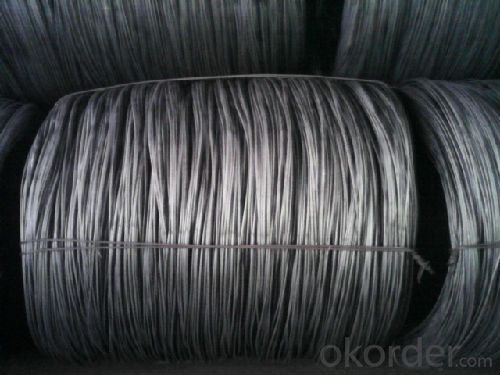
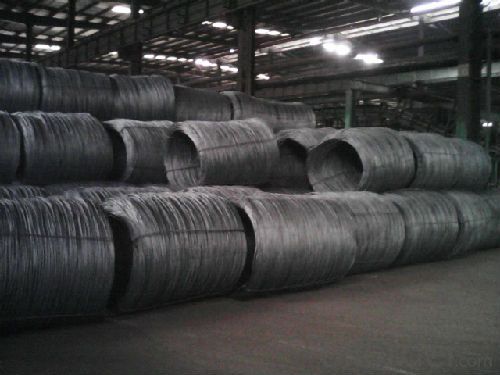
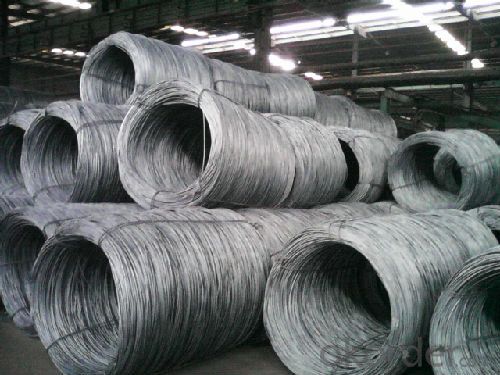
- Q:How is steel wire rod used in the production of reinforcement bars?
- Steel wire rod is used in the production of reinforcement bars by being heated and passed through a series of dies to form the desired shape and size. This process, known as hot rolling, helps strengthen the steel wire rod and enhances its ductility, making it suitable for use in reinforcement bars. The reinforcement bars, also known as rebars, are then used to provide strength and support to concrete structures, such as buildings, bridges, and highways, by reinforcing them against tension and bending forces. Overall, steel wire rod plays a vital role in the production of reinforcement bars, ensuring the durability and structural integrity of various construction projects.
- Q:How is steel wire rod used in the manufacturing of wire forms for signage?
- Steel wire rod is used in the manufacturing of wire forms for signage as it provides strength and durability to the final product. The wire rod is first shaped into the desired form, such as letters or shapes, and then further processed to ensure smoothness and uniformity. This wire form is then used as the base to attach various materials like lights, acrylic panels, or vinyl, allowing for the creation of intricate and eye-catching signage designs.
- Q:How is steel wire rod used in the production of wire for mesh filters?
- Steel wire rod is an essential component in the production of wire for mesh filters. The wire rod is first processed through a series of steps to ensure its quality and performance. It is often hot rolled to achieve the desired shape, size, and strength. This process involves heating the steel wire rod to high temperatures and passing it through a series of rollers to shape it into a uniform and continuous wire. Once the wire rod is hot rolled, it is then cooled and further processed to remove any scale or imperfections on its surface. This ensures that the wire is smooth and free from any defects that could compromise the quality of the final mesh filter. The wire rod is then drawn through a series of dies to reduce its diameter and increase its length. This process, known as wire drawing, also helps improve the wire's strength and tensile properties. The drawn wire is then either woven or welded to form the mesh filter. In the weaving process, the wire is interlaced in a crisscross pattern to create a mesh structure. This method is commonly used for finer mesh filters that require high precision and accuracy. On the other hand, the welding process involves joining individual wires together using heat or pressure to create a solid mesh structure. This method is typically used for larger mesh filters or those that require higher strength and durability. The steel wire rod used in the production of wire for mesh filters is crucial as it determines the quality and performance of the final product. The composition and tensile strength of the wire rod are carefully selected to meet the specific requirements of the mesh filter. It is important to use a high-quality wire rod that offers excellent corrosion resistance, durability, and dimensional stability to ensure the longevity and effectiveness of the mesh filter. In summary, steel wire rod plays a vital role in the production of wire for mesh filters. It undergoes various processes such as hot rolling, wire drawing, and surface treatment to achieve the desired properties. The wire rod is then woven or welded to form the mesh structure, which determines the filter's precision, strength, and durability. By using high-quality steel wire rod, manufacturers can produce superior mesh filters that effectively meet the filtration needs of various industries.
- Q:How is steel wire rod used in the aerospace industry?
- Steel wire rod is commonly used in the aerospace industry for various applications such as cable manufacturing, fasteners, and structural components. It provides high tensile strength, durability, and resistance to corrosion, making it suitable for critical applications like aircraft cables, engine components, and structural reinforcements. Additionally, steel wire rod is often used in the production of springs, which are crucial for ensuring reliable and efficient operation of aerospace systems.
- Q:How is steel wire rod used in the manufacturing of wire rope slings for marine applications?
- Steel wire rod is a crucial component in the manufacturing of wire rope slings for marine applications. These slings are extensively used in various marine industries, including shipping, offshore oil and gas, and fishing. To begin with, steel wire rod serves as the raw material for wire rope slings. It is typically made from high-quality carbon or alloy steel, which ensures the strength and durability required for marine applications. The steel wire rod is usually produced in a continuous casting process, resulting in a long, cylindrical shape. Once the steel wire rod is obtained, it undergoes a series of manufacturing processes to transform it into wire rope slings. The first step involves drawing the steel wire rod through a die to reduce its diameter and increase its length. This process is repeated multiple times to achieve the desired wire diameter. The drawn wire is then cleaned to remove any impurities or surface contaminants. Next, the cleaned wire is twisted together to form strands. The number of strands can vary depending on the desired strength and load capacity of the wire rope sling. These strands are then tightly wound around a central core, which provides stability and support to the wire rope. The final step in the manufacturing process is the application of protective coatings to enhance the wire rope sling's resistance to corrosion and wear. Marine environments are highly corrosive due to the presence of saltwater, which can lead to the degradation of steel. Therefore, coatings such as galvanization or zinc plating are commonly applied to the wire rope to provide a barrier against corrosion. Once the steel wire rod has been transformed into a wire rope sling, it is ready for use in various marine applications. Wire rope slings are used for a wide range of purposes, including lifting heavy loads, securing cargo, and towing vessels. They are known for their high strength, flexibility, and resistance to abrasion, making them ideal for demanding marine environments. In conclusion, steel wire rod plays a vital role in the manufacturing of wire rope slings for marine applications. It serves as the raw material for wire rope production, undergoes various manufacturing processes, and is ultimately transformed into a strong and durable sling. Wire rope slings made from steel wire rod are essential tools in the marine industry, providing reliable and safe lifting and securing capabilities.
- Q:What are the common production processes for tungsten-coated steel wire rod?
- The common production processes for tungsten-coated steel wire rod typically include wire drawing, cleaning, coating, and heat treatment. Initially, the steel wire rod is drawn through a series of dies to reduce its diameter and improve its surface finish. After the wire drawing process, the wire rod is cleaned to remove any impurities. Then, a layer of tungsten is applied to the surface of the wire rod through various coating techniques such as electroplating or vapor deposition. Finally, the coated wire rod undergoes a heat treatment process to enhance the adhesion between the tungsten coating and the steel wire, resulting in a durable and high-quality product.
- Q:What are the common applications of oil quenched and tempered steel wire rod?
- Oil quenched and tempered steel wire rod possesses unique properties that make it suitable for a diverse range of industries. Its applications include: 1. Automotive Industry: The automotive industry extensively utilizes oil quenched and tempered steel wire rod to manufacture various components, including suspension springs, engine valve springs, clutch springs, and transmission gears. The material's high strength and excellent fatigue resistance make it ideal for these demanding applications. 2. Construction Industry: In the construction industry, this type of steel wire rod is widely employed to produce high-strength wire ropes, prestressed concrete wires, and reinforcement bars. Its exceptional strength and durability enable it to withstand heavy loads and extreme conditions in construction projects. 3. Manufacturing Industry: Within the manufacturing sector, this steel wire rod is utilized to produce high-strength fasteners like bolts, nuts, and screws that require resistance to deformation. It is also used in the manufacturing of machinery components, such as gears, shafts, and springs, where toughness and wear resistance are crucial. 4. Oil and Gas Industry: The oil and gas industry extensively relies on oil quenched and tempered steel wire rod for applications like wireline cables, well drilling components, and downhole equipment. The material's high tensile strength and corrosion resistance enable it to endure the harsh conditions encountered in oil and gas exploration and production. 5. Aerospace Industry: The aerospace industry employs this steel wire rod in the production of aircraft cables, landing gear components, and structural parts. Its combination of high strength, fatigue resistance, and light weight make it an ideal choice for these critical applications. In summary, oil quenched and tempered steel wire rod is a versatile material that demonstrates exceptional strength, durability, and resistance to deformation. As a result, it finds applications across a wide range of industries.
- Q:How does the quality of steel wire rod affect the performance of wire products?
- The quality of steel wire rod significantly affects the performance of wire products. High-quality wire rod ensures superior strength, durability, and resistance to corrosion, which are crucial for wire products to function optimally. Inferior quality wire rod may result in weakened wire products that are more prone to breakage, reduced conductivity, and lower overall performance. Therefore, using high-quality steel wire rod is essential to produce reliable and high-performing wire products.
- Q:What are the common industry guidelines for steel wire rod professionals?
- Common industry guidelines for steel wire rod professionals include adhering to safety protocols, such as wearing appropriate personal protective equipment (PPE) and following proper handling and storage procedures. Professionals are also expected to maintain the quality of wire rod products by conducting regular inspections, ensuring compliance with industry standards and specifications, and efficiently managing inventory. Additionally, professionals are encouraged to stay updated on the latest technological advancements, maintain good communication with colleagues and customers, and continuously improve their knowledge and skills through training and professional development opportunities.
- Q:What are the different types of steel wire rod surface cleaning methods after wire drawing?
- There are several types of steel wire rod surface cleaning methods after wire drawing, including mechanical cleaning methods such as shot blasting, wire brushing, and sanding. Chemical cleaning methods like pickling and acid washing can also be used. Additionally, thermal cleaning methods like annealing and heat treatment can help remove impurities and improve the surface quality of the steel wire rod.
1. Manufacturer Overview |
|
|---|---|
| Location | |
| Year Established | |
| Annual Output Value | |
| Main Markets | |
| Company Certifications | |
2. Manufacturer Certificates |
|
|---|---|
| a) Certification Name | |
| Range | |
| Reference | |
| Validity Period | |
3. Manufacturer Capability |
|
|---|---|
| a)Trade Capacity | |
| Nearest Port | |
| Export Percentage | |
| No.of Employees in Trade Department | |
| Language Spoken: | |
| b)Factory Information | |
| Factory Size: | |
| No. of Production Lines | |
| Contract Manufacturing | |
| Product Price Range | |
Send your message to us
Wire Rods Steel for Construction/ Concrete Usage
- Loading Port:
- Tianjin
- Payment Terms:
- TT or LC
- Min Order Qty:
- 28 m.t.
- Supply Capability:
- 40000 m.t./month
OKorder Service Pledge
OKorder Financial Service
Similar products
New products
Hot products
Hot Searches
Related keywords
